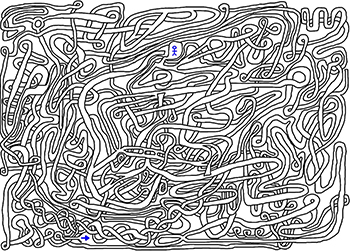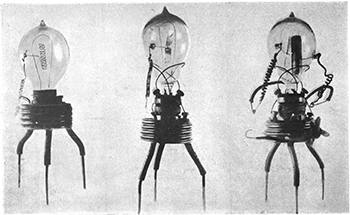"data scientists" entries

Using Apache Spark to predict attack vectors among billions of users and trillions of events
The O’Reilly Data Show podcast: Fang Yu on data science in security, unsupervised learning, and Apache Spark.
Subscribe to the O’Reilly Data Show Podcast to explore the opportunities and techniques driving big data and data science: Stitcher, TuneIn, iTunes, SoundCloud, RSS.
In this episode of the O’Reilly Data Show, I spoke with Fang Yu, co-founder and CTO of DataVisor. We discussed her days as a researcher at Microsoft, the application of data science and distributed computing to security, and hiring and training data scientists and engineers for the security domain.
DataVisor is a startup that uses data science and big data to detect fraud and malicious users across many different application domains in the U.S. and China. Founded by security researchers from Microsoft, the startup has developed large-scale unsupervised algorithms on top of Apache Spark, to (as Yu notes in our chat) “predict attack vectors early among billions of users and trillions of events.”
Several years ago, I found myself immersed in the security space and at that time tools that employed machine learning and big data were still rare. More recently, with the rise of tools like Apache Spark and Apache Kafka, I’m starting to come across many more security professionals who incorporate large-scale machine learning and distributed systems into their software platforms and consulting practices.

Building a business that combines human experts and data science
The O’Reilly Data Show podcast: Eric Colson on algorithms, human computation, and building data science teams.
Subscribe to the O’Reilly Data Show Podcast to explore the opportunities and techniques driving big data and data science.
In this episode of the O’Reilly Data Show, I spoke with Eric Colson, chief algorithms officer at Stitch Fix, and former VP of data science and engineering at Netflix. We talked about building and deploying mission-critical, human-in-the-loop systems for consumer Internet companies. Knowing that many companies are grappling with incorporating data science, I also asked Colson to share his experiences building, managing, and nurturing, large data science teams at both Netflix and Stitch Fix.
Augmented systems: “Active learning,” “human-in-the-loop,” and “human computation”
We use the term ‘human computation’ at Stitch Fix. We have a team dedicated to human computation. It’s a little bit coarse to say it that way because we do have more than 2,000 stylists, and these are very much human beings that are very passionate about fashion styling. What we can do is, we can abstract their talent into—you can think of it like an API; there’s certain tasks that only a human can do or we’re going to fail if we try this with machines, so we almost have programmatic access to human talent. We are allowed to route certain tasks to them, things that we could never get done with machines. … We have some of our own proprietary software that blends together two resources: machine learning and expert human judgment. The way I talk about it is, we have an algorithm that’s distributed across the resources. It’s a single algorithm, but it does some of the work through machine resources, and other parts of the work get done through humans.

Is 2016 the year you let robots manage your money?
The O’Reilly Data Show podcast: Vasant Dhar on the race to build “big data machines” in financial investing.
Subscribe to the O’Reilly Data Show Podcast to explore the opportunities and techniques driving big data and data science.
In this episode of the O’Reilly Data Show, I sat down with Vasant Dhar, a professor at the Stern School of Business and Center for Data Science at NYU, founder of SCT Capital Management, and editor-in-chief of the Big Data Journal (full disclosure: I’m a member of the editorial board). We talked about the early days of AI and data mining, and recent applications of data science to financial investing and other domains.
Dhar’s first steps in applying machine learning to finance
I joke with people, I say, ‘When I first started looking at finance, the only thing I knew was that prices go up and down.’ It was only when I actually went to Morgan Stanley and took time off from academia that I learned about finance and financial markets. … What I really did in that initial experiment is I took all the trades, I appended them with information about the state of the market at the time, and then I cranked it through a genetic algorithm and a tree induction algorithm. … When I took it to the meeting, it generated a lot of really interesting discussion. … Of course, it took several months before we actually finally found the reasons for why I was observing what I was observing.

Investing in big data technologies
The O’Reilly Data Show podcast: A fireside chat with Ben Horowitz, plus Reynold Xin on the rise of Apache Spark in China.
Subscribe to the O’Reilly Data Show Podcast to explore the opportunities and techniques driving big data and data science.
In this special holiday episode of the O’Reilly Data Show, I look back at two conversations I had earlier this year at the Spark Summit in San Francisco. The first segment is an on-stage fireside chat with Ben Horowitz, co-founder of Andreessen Horowitz and author of The Hard Thing About Hard Things.
In the second segment, Reynold Xin, one of the architects of Apache Spark, explains the rise of Apache Spark in China.
Related resources:
- State of Spark, and where it is going in 2016: a Strata + Hadoop World San Jose presentation by Apache Spark architects, Reynold Xin and Patrick Wendell.
- Dates for Spark Summit 2016 conferences are now available.
- Learning Spark
- Real-time data applications

Patrick Wendell on Spark’s roadmap, Spark R API, and deep learning on the horizon
The O'Reilly Radar Podcast: A special holiday cross-over of the O'Reilly Data Show Podcast.
Subscribe to the O’Reilly Radar Podcast to track the technologies and people that will shape our world in the years to come.
In this special holiday episode of the Radar Podcast, we’re featuring a cross-over of the O’Reilly Data Show Podcast, which you can find on iTunes, Stitcher, TuneIn, or SoundCloud. O’Reilly’s Ben Lorica hosts that podcast, and in this episode, he chats with Apache Spark release manager and Databricks co-founder Patrick Wendell about the roadmap of Spark and where it’s headed, and interesting applications he’s seeing in the growing Spark ecosystem.
Here are some highlights from their chat:
We were really trying to solve research problems, so we were trying to work with the early users of Spark, getting feedback on what issues it had and what types of problems they were trying to solve with Spark, and then use that to influence the roadmap. It was definitely a more informal process, but from the very beginning, we were expressly user driven in the way we thought about building Spark, which is quite different than a lot of other open source projects. … From the beginning, we were focused on empowering other people and building platforms for other developers.
One of the early users was Conviva, a company that does analytics for real-time video distribution. They were a very early user of Spark, they continue to use it today, and a lot of their feedback was incorporated into our roadmap, especially around the types of APIs they wanted to have that would make data processing really simple for them, and of course, performance was a big issue for them very early on because in the business of optimizing real-time video streams, you want to be able to react really quickly when conditions change. … Early on, things like latency and performance were pretty important.

Building a scalable platform for streaming updates and analytics
The O’Reilly Data Show podcast: Evan Chan on the early days of Spark+Cassandra, FiloDB, and cloud computing.
Subscribe to the O’Reilly Data Show Podcast to explore the opportunities and techniques driving big data and data science.
In this episode of the O’Reilly Data Show, I sit down with Evan Chan, distinguished engineer at Tuplejump. We talk about the early days of Spark (particularly his contributions to Spark/Cassandra integration), his interesting new open source project (FiloDB), and recent trends in cloud computing.
Bringing Apache Spark & Apache Cassandra together
Datastax credits me with inspiring them to bring Spark into Cassandra … I think they’re very generous about that. I think I was one of the first folks to talk about the possibility of bringing Cassandra and Spark together. The vision that I saw was that Cassandra was really good for real-time updates, but what if we’re able to do more analytical queries on it? Then you could combine, basically, a platform that is really good for real-time updates with analytics.

Jai Ranganathan on architecting big data applications in the cloud
The O’Reilly Data Show podcast: The Hadoop ecosystem, the recent surge in interest in all things real time, and developments in hardware.
Subscribe to the O’Reilly Data Show Podcast to explore the opportunities and techniques driving big data and data science.
Given the quick pace of innovation in the data ecosystem, we like to take a step back from the details of individual components, architecture, and applications, in order to take a wider view of the landscape of big data. This allows us to evaluate the progress of technology and infrastructure along the way, shifting our attention from the details of individual components like Spark and Kafka, to larger trends.
Some of the larger trends we’ve been exploring include the capabilities of distributed machine learning and the tradeoffs and design decisions involved in cloud architecture and stream processing.
In this episode of the O’Reilly Data Show, I sat down with Jai Ranganathan, senior director of product management at Cloudera. We talked about the trends in the Hadoop ecosystem, cloud computing, the recent surge in interest in all things real time, and hardware trends:
Large-scale machine learning
This sounds a bit like this should already exist in really good form right now, but one of the things that I’m really interested in is expanding the set of capabilities for distributed machine learning. While there are systems out there today that do do this, I think relative to what you can experience from a singular environment learning scikit-learn or R, the set of things you can do in a distributed fashion is limited. … It’s not easy to distribute various algorithms and model-building techniques. I think there is still a lot of work for us to do to improve that experience. … And I do want to have good open source options like MLlib. MLlib may be the right answer. I would be perfectly happy if that’s the final answer, but we do need systems just to provide the kind of depth that you typically are used to in the singular environment. That’s just a matter of time and investment because these are non-trivial problems, but they are things that people are working on.

Building systems for massive scale data applications
The O’Reilly Data Show podcast: Tyler Akidau on the evolution of systems for bounded and unbounded data processing.
Subscribe to the O’Reilly Data Show Podcast to explore the opportunities and techniques driving big data and data science.
Many of the open source systems and projects we’ve come to love — including Hadoop and HBase — were inspired by systems used internally within Google. These systems were described in papers and implemented by people who needed frameworks that could comfortably scale to massive data sets.
Google engineers and scientists continue to publish interesting papers, and these days some of the big data systems they describe in publications are available on their cloud platform.
In this episode of the O’Reilly Data Show, I sat down with Tyler Akidau one of the lead engineers in Google’s streaming and Dataflow technologies. He recently wrote an extremely popular article that provided a framework for how to think about bounded and unbounded data processing (a follow-up article is due out soon). We talked about the evolution of stream processing, the challenges of building systems that scale to massive data sets, and the recent surge in interest in all things real time:
On the need for MillWheel: A new stream processing engine
At the time [that MillWheel was built], there was, as far as I know, literally nothing externally that could handle the scale that we needed to handle. A lot of the existing streaming systems didn’t focus on out-of-order processing, which was a big deal for us internally. Also we really wanted to hit a strong focus on consistency — being able to get absolutely correct answers. … All three of these things were lacking in at least some area in [the systems we examined].

Turning big data into actionable insights
The O’Reilly Data Show podcast: Evangelos Simoudis on data mining, investing in data startups, and corporate innovation.
Subscribe to the O’Reilly Data Show Podcast to explore the opportunities and techniques driving big data and data science.
Can developments in data science and big data infrastructure drive corporate innovation? To be fair, many companies are still in the early stages of incorporating these ideas and tools into their organizations.
Evangelos Simoudis has spent many years interacting with entrepreneurs and executives at major global corporations. Most recently, he’s been advising companies interested in developing long-term strategies pertaining to big data, data science, cloud computing, and innovation. He began his career as a data mining researcher and practitioner, and is counted among the pioneers who helped data mining technologies get adopted in industry.
In this episode of the O’Reilly Data Show, I sat down with Simoudis and we talked about his thoughts on investing, data applications and products, and corporate innovation:
Open source software companies
I very much appreciate open source. I encourage my portfolio companies to use open source components as appropriate, but I’ve never seen the business model as being one that is particularly easy to really build the companies around them. Everybody points to Red Hat, and that may be the exception, but I have not seen companies that have, on the one hand, remained true to the open source principles and become big and successful companies that do not require constant investment. … The revenue streams never prove to be sufficient for building big companies. I think the companies that get started from open source in order to become big and successful … [are] ones that, at some point, decided to become far more proprietary in their model and in the services that they deliver. Or they become pure professional services companies as opposed to support services companies. Then they reach the necessary levels of success.









